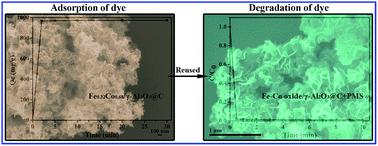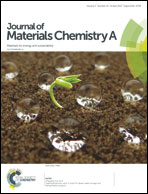Synthesis of Fe0.32Co0.68/γ-Al2O3@C nanocomposite for depth treatment of dye sewage based on adsorption and advanced catalytic oxidation†
Abstract
Herein, Fe0.32Co0.68 binary metal nanoparticles synthesized at room-temperature were loaded onto a novel hierarchical flower-like γ-Al2O3@C composite, which improved the stability and dispersity of the Fe0.32Co0.68 nanoparticles. The freshly prepared Fe0.32Co0.68/γ-Al2O3@C displayed good adsorption of Orange II (100 mg L−1, 973.55 mg g−1). Subsequently, the used Fe0.32Co0.68/γ-Al2O3@C adsorbent (Fe–Co oxide/γ-Al2O3@C) was reused as a peroxymonosulfate (PMS) catalyst. Amazing results were obtained, which demonstrated that Fe–Co oxide/γ-Al2O3@C can highly efficiently decompose Orange II (60 mg L−1, 1 min; 90 mg L−1, 2 min, 120 mg L−1, 7 min and 150 mg L−1, 10 min) as a PMS catalyst. It also exhibited good general degradation of different organic pollutants and excellent reusability (98%, tenth cycle) due to the structural stabilities of γ-Al2O3@C. Further, an experiment was carried out to treat high concentrations of Orange II (200 mg L−1) with the Fe0.32Co0.68/γ-Al2O3@C nanocomposite. After adsorption, PMS was added, and 98% degradation occurred within 5 minutes. The combination of adsorption and PMS advanced oxidation techniques may be one of the effective ways to deal with high-concentration dye wastewater.



 Please wait while we load your content...
Please wait while we load your content...